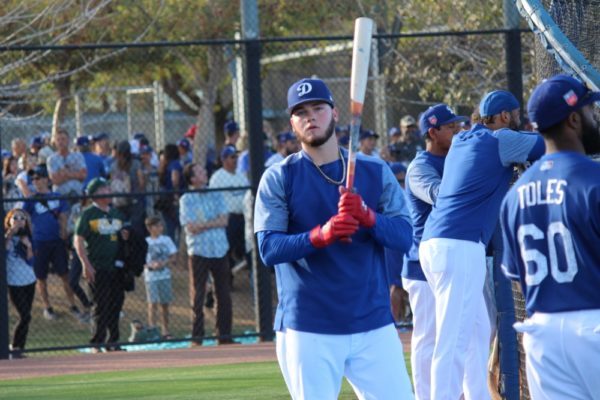
For the better part of the last six years, right field in Dodger Stadium has been manned primarily by one player: Yasiel Puig. But now that he’s a Red (sigh), someone else will get the lion’s share of the playing time at the position.
With top prospect Alex Verdugo still with the organization and the team opening up right field, it’s going to be him … right? Not so fast.
Well then. It appears Cody Bellinger will be the team’s primary right fielder in 2019. And with the declaration that the Dodgers want him to play everyday, that means Verdugo won’t get much of a shot there.
That’s not to cast any aspersions on Bellinger. He’s probably the best defensive outfielder on the 40-man roster (and among the best in the entire organization), and we all remember this from last year’s NLCS.
So yeah, he can play the position. This is more about what the Dodgers acutally plan to do with Verdugo.
Joc Pederson is still around, despite trade rumors over the last month. Against right-handed pitching, Pederson’s 139 wRC+ was the 22nd-best in the baseball last season (minimum 300 plate appearances). He crushes right-handed pitching, so it’d be foolish if he were to sit against them in favor of a mostly unproven rookie. At the same time, when is Verdugo going to get his shot, if not now?
Maybe he’ll play against left-handed pitching. He has a .318/.376/.434 triple slash line in 493 career minor-league at-bats against southpaws. He could, conceivably, start against them in left field, but that would mean playing a rookie left-handed hitter ahead of either Enrique Hernandez or Chris Taylor, both of whom have good reputations against southpaws.
A.J. Pollock is going to be the starting center fielder and probably isn’t going to play 162 games, so there will be opportunities for the Dodgers to spread the playing time among Hernandez, Pederson, Taylor and Verdugo (and maybe Andrew Toles), but that might not be the best thing for Verdugo.
And Verudgo has been ready for a full-time gig in the majors since the beginning of last season. With the Dodgers’ outfield glut, it was understandable that he spent most of 2018 with Oklahoma City. After trading two outfielders and not trading Verdugo in rumored deals for Corey Kluber and/or J.T. Realmuto, it seemed like the Dodgers were ready to give Verdugo a shot. The signing of Pollock changed those plans a bit.
This could be a situation where things work themselves out — you know, depth and injuries and such — but what if everyone stays relatively healthy? Verdugo can’t spend significant time in Triple-A this season. He has almost 900 plate appearances there over the last two seasons and has hit to a .321/.389/.452. He has nothing left to prove. The Dodgers owe it to him to see if he can handle a full-time job. The way things are currently constructed, though, that doesn’t seem like it’ll happen.
Pederson could still be traded, but it seems more and more like the players here now are the ones who will be on the roster heading into the 2019 season (minus potentially minor trades, a la the Chase De Jong/Drew Jackson deal a couple years ago).
I’m not worried about Bellinger being able to handle right field. He’s a really good outfielder, and while his arm may not be as good as Verdugo’s, he’s probably better in every other aspect of the position. Plus, that would give the Dodgers a plus-plus arm in left field, which is rare. That is, if Verdugo actually gets to play left field consistently. We’ll see what happens, but we’re long overdue for the Dodgers to free Alex Verdugo.
 Dodgers Digest Los Angeles Dodgers Baseball Blog
Dodgers Digest Los Angeles Dodgers Baseball Blog